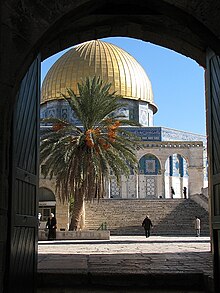| Revision as of 02:40, 23 November 2008 editMystBot (talk | contribs)177,678 editsm robot Modifying: pt:Bairro Muçulmano← Previous edit | Revision as of 01:10, 12 December 2008 edit undoChesdovi (talk | contribs)Autopatrolled, Extended confirmed users22,098 edits →See alsoNext edit → | ||
| Line 18: | Line 18: | ||
| == See also == | == See also == | ||
| * ] | |||
| * ] | |||
| * ] | * ] | ||
| * ] | |||
| * ] | * ] | ||
Revision as of 01:10, 12 December 2008


The Muslim Quarter is one of the four quarters of the ancient, walled Old City of Jerusalem, the other three being the Jewish Quarter, the Christian Quarter and the Armenian Quarter. The Muslim Quarter is the largest and most populous of the four quarters and is situated in the northeastern corner of the Old City, extending from the Lions' Gate in the east, along the northern wall of the Temple Mount in the south, to the Damascus Gate - Western Wall route in the west. The Via Dolorosa road starts in the quarter.

The population of the Muslim Quarter is 22,000. Like the other three quarters of the Old City, the Muslim quarter had a mixed population of Jews as well as Muslims and Christians until the riots of 1929. Today 60 Jewish families live in the Muslim Quarter, and a few yeshivot are located there. The main one is Yeshivat Ateret Cohanim. Jewish landmarks within the quarter include the Kotel Katan or Little Western Wall, and the Western Wall Tunnels, which run below the neighborhood along the Western Wall.
On July 27, 2005, Israeli planners approved the construction of Jewish housing in the Muslim Quarter, a few meters from the al-Aqsa Mosque. It will contain thirty apartments on three dunums of land.
External links
- HD Virtual Tour of the Muslim Quarter - December 2007
- HD Virtual Tour of the Muslim Quarter - December 2007
- HD Virtual Tour of a Souvenir shop in the Muslim Quarter - December 2007
References
- ^ Muslim Quarter of the "Old City" section of Jerusalem
- New Jewish Settlement in Muslim Quarter of Jerusalem Old City near Al Aqsa Mosque could ignite a Third Intifada
See also
| Neighborhoods of Jerusalem | |
|---|---|
| Jerusalem neighborhoods in East Jerusalem are depicted in green, those in West Jerusalem in blue (see Green Line). | |
| Old City | |
| Central |
|
| Northern |
|
| Eastern | |
| Southern | |
| Western | |
| Historical | |
| |
Categories:
